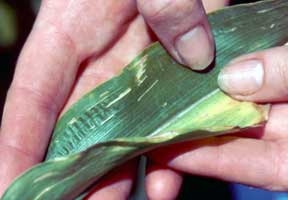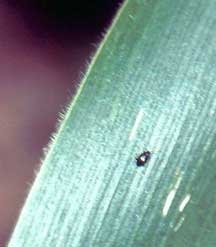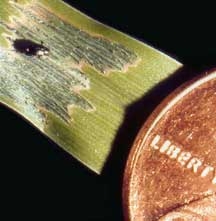Corn flea beetle, sweet corn and Stewart’s wilt
Editor’s note: This article is from the archives of the MSU Crop Advisory Team Alerts. Check the label of any pesticide referenced to ensure your use is included.
The corn flea beetle is a small, black beetle that feeds as an adult on a variety of grasses, including sweet corn. Feeding by corn flea beetle produces linear scars along the leaf. Usually corn flea beetles do not directly damage corn. They do, however, vector the bacterial disease, Stewart’s wilt. This disease can cause wilting, stunting, and reduced stand and yield in sweet corn.

Corn flea beetle feeding.

Corn flea beetle on corn leaf.

Corn flea beetle on leaf next to penny.
The Stewart’s wilt bacterium lives in plants and in the gut of flea beetle. Flea beetles acquire the disease when feeding on a diseased plant. Infected flea beetles, in turn, infect new plants by feeding on them.
Corn flea beetles survive the winter as adults hidden among leaf litter and debris in ditch banks, hedgerows and other areas bordering fields. Some beetles that emerge in the spring may carry the Stewart’s wilt bacterium in their guts, having become infected the previous season. Wild grasses may also harbor Stewart’s wilt, but whether they are an overwintering source of the pathogen, is not yet known.
In Michigan, the severity of Stewart’s wilt has varied considerably from year to year, in part depending on winter temperatures. When winters are mild, more beetles survive and sweet corn growers experience more problems with Stewart’s wilt. The winter of 2006-07 was a mixture of higher than normal temperatures early with lower than normal temperatures in February. Overall, the winter’s temperatures were not exceedingly warm. However, we do not know if the warmer than normal temperatures early in the winter (December through mid January) influenced survival. Also, flea beetle survival may be higher than predicted when heavy snow cover occurs during periods of low temperatures. The risk of Stewart’s wilt may also be influenced by the abundance of overwintering flea beetles infected with the disease. In Michigan, late in the 2006 growing season, many field corn fields showed symptoms of Stewart’s wilt, which may indicate more infected corn flea beetles than usual.
Given this, sweet corn in south and central Michigan may be at risk for Stewart’s wilt infection. The most effective method of control is by planting sweet corn varieties that are resistant or tolerant to the disease. View reports of sweet corn variety evaluations for resistance to Stewart’s wilt.
If growers are planting a susceptible variety in an area that is prone to Stewart’s wilt, insecticides may be used to control flea beetles. Sweet corn plants are most vulnerable to Stewart’s wilt when they are small. In general, the smaller the plant, the greater the impact Stewart’s wilt has. Control of corn flea beetle is only needed until the 7-leaf stage. The most effective option is to purchase seed that has been treated with systemic insecticides (Gaucho, Cruiser, or Poncho). These insecticides are effective against corn flea beetles and the protection lasts until the 5th true leaf stage. Several soil insecticides are also effective against corn flea beetle feeding. Of these, Furadan 4F gives the best control. Alternatively, Counter 15G or Thimet 20 G may be used. These products will give control for two to four weeks.
If growers are planting more tolerant varieties, or if they are growing corn in areas that do not usually experience problems with Stewart’s wilt, scouting fields for corn flea beetles and feeding damage and applying a foliar insecticide when needed may be the best option. Field should be scouted two to three times per week, especially near the field edges, from germination until the 7-leaf stage. Flea beetles are best observed on a sunny day with little wind (they hide in the corn plant if it is cloudy, cold or windy). The treatment threshold is 6 beetles per 100 plants for susceptible varieties and 2 beetles per plant in combination with feeding damage on 25 percent of plants for resistant varieties. A number of foliar insecticides are registered and are effective against corn flea beetles (see Bulletin E-312: 2007 Insect, Disease and Nematode Control for Commercial Vegetables). Keep in mind, however, that the corn plant is growing rapidly early in the season and any new growth since the last application is not protected. In addition, flea beetles are very mobile and may move into the field from the borders after the application and feed on the unprotected foliage.
By time the corn plant reaches the 7-leaf stage corn flea beetle control is no longer needed. Although flea beetles may still feed on the corn and may still infect it with Stewart’s wilt, the plant is large enough to tolerate the infection without any damage to yield or quality.



 Print
Print Email
Email


